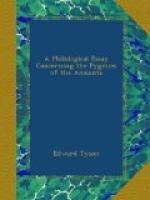[Footnote A: The quotation is taken from Ritson, Fairy Tales, P. 4.]
De Quatrefages also thinks that an allusion to the ancestors of the Jats, who would then have been less altered by crossing than now, may be found in Herodotus’ account of the army of Xerxes when he says, “The Eastern Ethiopians serve with the Indians. They resemble the other Ethiopians, from whom they only differ in language and hair. The Eastern Ethiopians have straight hair, while those of Lybia are more woolly than all other men.”
Writing of isles in the neighbourhood of Java, Maundeville says,[A] “In another yle, ther ben litylle folk, as dwerghes; and thei ben to so meche as the Pygmeyes, and thei han no mouthe, but in stede of hire mouthe, thei han a lytylle round hole; and whan thei schulle eten or drynken, thei taken thorghe a pipe or a penne or suche a thing, and sowken it in, for thei han no tongue, and therefore thei speke not, but thei maken a maner of hissynge, as a Neddre dothe, and thei maken signes on to another, as monkes don, be the whiche every of hem undirstondethe the other.”
[Footnote A: Ed. Halliwell, p. 205.]
Strip this statement of the characteristic Maundevillian touches with regard to the mouth and tongue, and it may refer to some of the insular races which exist or existed in the district of which he is treating.
A much fuller account[A] by the same author relates to Pigmies in the neighbourhood of a river, stated by a commentator[B] to be the Yangtze-Kiang, “a gret ryvere, that men clepen Dalay, and that is the grettest ryvere of fressche water that is in the world. For there, as it is most narow, it is more than 4 myle of brede. And thanne entren men azen in to the lond of the great Chane. That ryvere gothe thorge the lond of Pigmaus, where that the folk ben of litylle stature, that ben but 3 span long, and thei ben right faire and gentylle, aftre here quantytees, bothe the men and the women. And thei maryen hem, whan thei ben half zere of age and getten children. And thei lyven not, but 6 zeer or 7 at the moste. And he that lyveth 8 zeer, men holden him there righte




